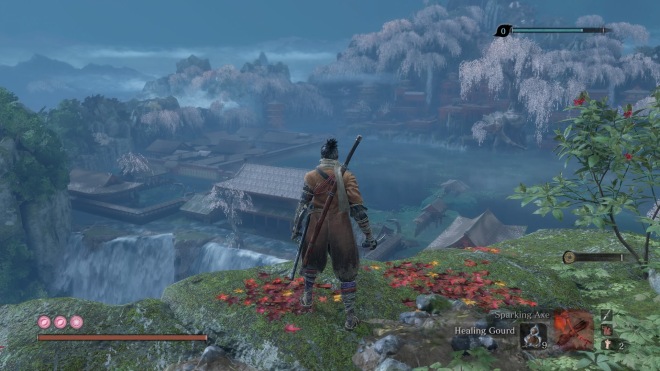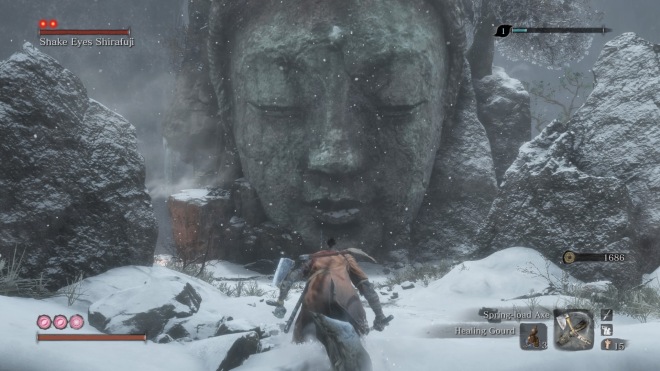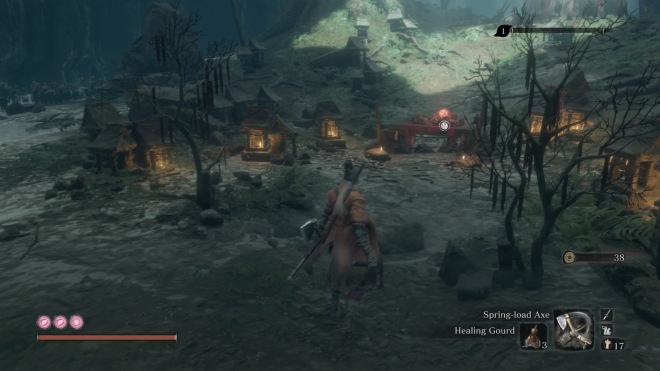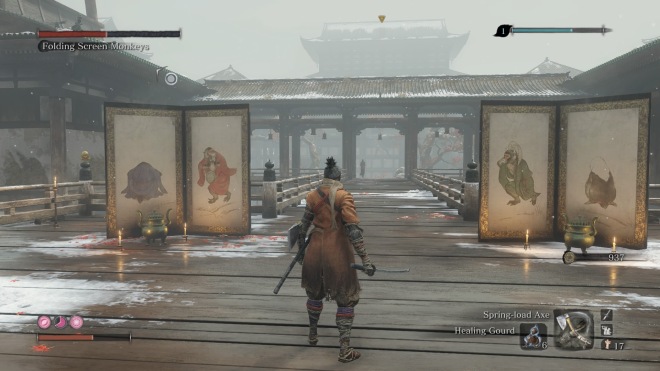FromSoftware never fails to surprise me with their ability to make their games feel familiar yet completely different at the same time. In Dark Souls, I found comfort hiding behind a shield and waiting for the right moments to get a few hits in. Bloodborne forced me out of this mindset after punishing my cautious play style numerous times. Now Sekiro has come along and, on the surface, appears to have slotted in between these two styles, demanding a mixture of defence and aggressive counter-attacks. But in practice, the transition is nowhere near as smooth as the one from Lothric to Yharnam and will divide opinion among diehard fans.
Combat aside, Sekiro is still an entirely different beast from its predecessors. There’s no character creation, no plethora of weapons to choose from or stats to level up. Instead, you only gain attack power and health by beating bosses and mini-bosses. On a scale from RPG to an action game, Sekiro perches much closer to the latter. If you’re looking for a Soulsborne with different set dressing, then you’ll probably be disappointed. It even has a more explicitly told story, though still obtuse by most narrative standards. Sacrilege right? Well, go in embracing the change, and you’ll find that Sekiro is a cracking game.
Set in a fictionalised version of Sengoku period Japan, Sekiro follows the titular character as he attempts to make good on his promise to follow the Iron Code to protect his master Kuro at all costs. The game promptly kicks off with Kuro being kidnapped, Sekiro is far from a perfect shinobi it has to be said, and we follow his journey to save him. It’s an interesting tale, if a little standard, largely due to Sekiro himself being a pretty dull character.
He barely says anything and seems to have very little interest when he does, save for a few moments. Whilst I can accept that it wasn’t From’s intention to let you create a character because they had their own story they wanted to tell, I feel Sekiro is enough of a blank slate that it wouldn’t have hurt to let people make their own shinobi and leave him voiceless.

Despite this, the compelling world-building FromSoftware is known for is still here and as strong as ever. Items you pick up from enemies or through looting abandoned temples shed more information about what’s going on in the world, and you’ll slowly piece together some interesting lore about this version of Japan. It also successfully maintains the sullen atmosphere that’s been a staple of FromSoftware games for a while now despite looking a lot more cheerful.
It’s a beautiful world to explore on the surface. It seems that the developers discovered an entirely new colour palette for Sekiro with pink and light blue foliage found in pleasing abundance. It all serves to create a stark contrast when you discover how broken this world is. Coming across an area with gorgeous lakes and serene mountains stretching in the distance suggests a peaceful village buried in the middle of it. But, appearances can be deceiving as you get up close and personal with these locales and discover how bad things have become.
Alongside being more traditionally beautiful, the way you explore Sekiro’s world is also different. Poor Sekiro gets his arm lopped off fairly early in the story before a former shinobi gives him a prosthetic arm replacement that allows him to, among other things, use it as a grappling hook to scale areas he couldn’t otherwise reach.
It takes adventuring to a new, literal, level. No longer do you have to stare up at amazing scenery and just think it looks cool. In Sekiro, you’ll be able to zip up most of it. It gives the feeling that you’re exploring the world in a way that other characters in the game simply can’t. In reality, it’s just replaced a pathway with a quick whoosh over a gap, but it makes you feel like you’re discovering impossible to reach places.

Beyond this, the prosthetic will also help you out in battle, whether that’s using the grapple arm feature to find a sneaky route around an enemy so you can get in a quick stealth kill or by using one of the many attachments in more overt combat. These include firecrackers that can be used to blind enemies, opening them up for a few free swings or some strange feather-based short-range teleportation device to get you out of a sticky situation. No really, that’s a thing.
As cool as these attachments are, you’ll probably only use a select few against specific bosses or enemies where they work incredibly well. For instance, there are enemies with shields that can be splintered with an axe prosthetic, leaving them vulnerable to a katana to the throat. But these lads only appear in a few areas, meaning you’d only be using the axe to inflict more posture damage (more on that later) or just because you like it (I did).
But for the most part, the game can be completed without using them, and you may forget they exist. This is more of a testament to the sword on sword combat than a knock on the prosthetics. As you’d expect from this developer, the gameplay is fantastic, with some of the most satisfying sword fighting I’ve ever experienced.
There’s no stamina in Sekiro. Instead, this has been replaced by a posture bar. When this bar gets filled by hitting the enemy enough, they’ll become stunned, opening them up for a deathblow. This wonderfully gory execution results in an almost comical shower of blood that makes you feel like the death-bringing shinobi we all want to be, whether we knew it or not.

But it’s not just the end result that’s satisfying. The whole process feels excellent. The posture bar will fill up regardless of if your opponent is blocking your attacks, so you’re encouraged to attack them even if their guard is up. This results in a glorious clanging of swords with sparks flying off them as they connect. This sound and visual double threat make a potentially repetitive combat system constantly enjoyable.
You cannot just attack with reckless abandon, though. After a few swipes at your enemy, there will be an orange aura in addition to sparks that will signify you’ve been deflected. It’s at this point you’ll want to go on the defensive. This means blocking just as their weapon makes contact with you, and getting the timing right will result in a successful deflection, filling their posture bar, bringing you closer to that sweet deathblow.
When perfectly timing these deflections, following a flurry of attacks, it’s incredibly satisfying to use the enemies aggression against them before punishing them with your own. Get the timing wrong, however, and you’ll likely meet a swift end. Here, Sekiro may become too frustrating for some people.
Sekiro demands near perfection. Most enemies can kill you in only a few hits, so if you screw up even for a second, the punishment is often death, particularly against the more difficult bosses. Even if you survive and heal back up, your opponent may have recovered their posture, meaning you’re effectively starting over again. It can feel insurmountable at times. You get an extra attempt thanks to the whole ‘Shadows Die Twice’ shtick, effectively meaning an extra life, which can balance out getting cut down instantly.

The punishment for dying is arguably harsher than in previous games. In Sekiro, you gain experience towards a skill point as well as Sen, the game’s currency. When you’ve got enough experience for that skill point, it’s banked and cannot be lost. But if you don’t and, die you’ll lose half of it. There is a percentage chance you won’t lose anything but this will decrease with more deaths and will require the use of a rare(ish) item to restore.
It certainly sounds harsh until you realise the skill tree isn’t that important after getting a few useful passives and extra moves. There are special moves called Combat Arts that you can equip one of. These fancy moves often don’t feel entirely necessary, so it’s a shame that the majority of the skill tree is populated with them. There are a couple that makes beating certain mini-bosses and bosses a non-event, though.
The bosses are, as you’d expect, mostly excellent. If you’re a proponent for the best bosses in From games being the 1 on 1 tussles with other (slightly oversized) humans, then Sekiro comes bearing many gifts. There are numerous, tough and enjoyable encounters with well-trained swordsmen and women that range from blindingly fast dagger wielders requiring quick reactions for deflections to heavier hitters armed with huge swords where dodging is preferred.
Unlike regular enemies, bosses and mini-bosses alike will require more than one deathblow, which means longer battles and multiple phases to learn. It helps to elevate them as opponents and raises the tension when you finally whittle them down to their last phase, hoping this will be the attempt where you finally take them out. There’s always a brief slow-motion pause before you deliver the final deathblow that gives you a moment to really savour your impending victory before plunging a katana into their chest. It feels so good.
Sekiro: Shadows Die Twice is an excellent game that’s also oddly difficult to recommend to new players and FromSoftware stalwarts alike. It can seem overly punishing at times, demanding a level of perfection that not every player is capable of, and there’s no option to bring someone in to help you. It’s also a huge departure from the RPG aspects of previous titles, which leaves it with very little replay value. However, it still has the excellent combat and world-building that FromSoftware is known for, so if you can click with the mechanics, you’re going to love Sekiro.
8/10
